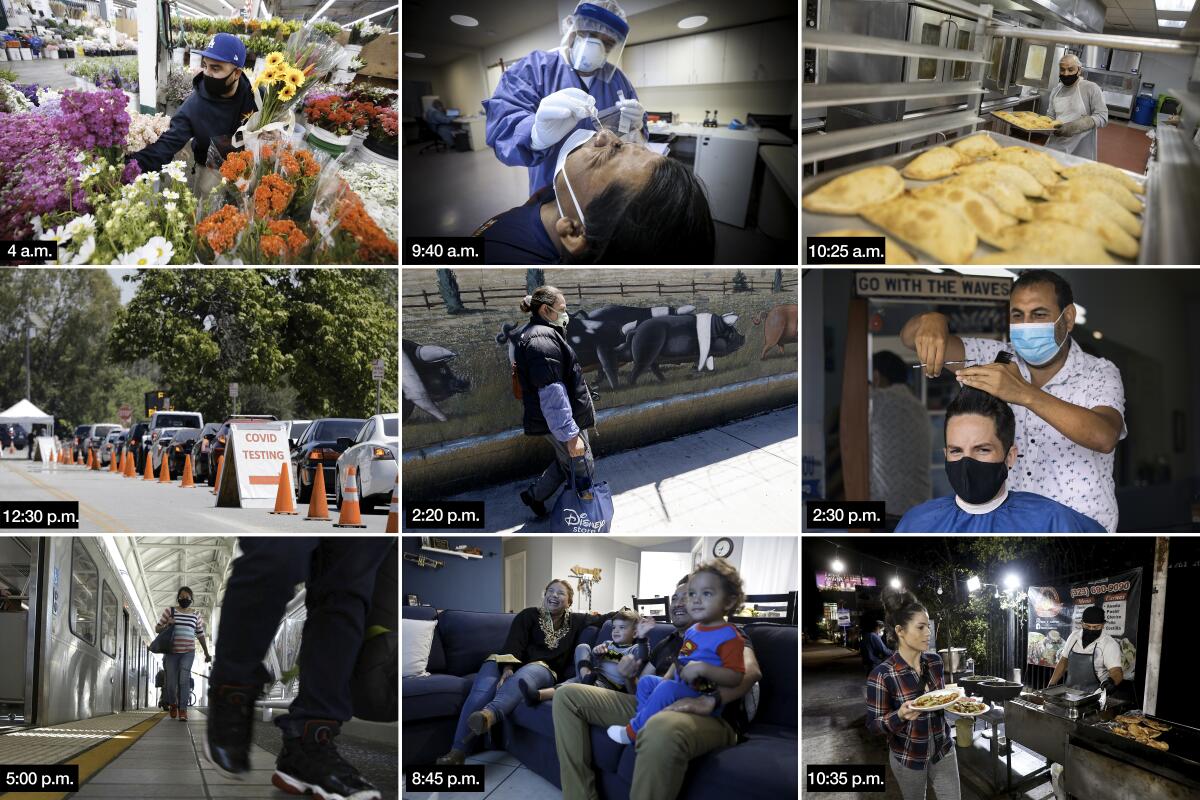Coronavirus Today: ‘Inefficient on so many levels’
Good evening. I’m Diya Chacko, and it’s Monday, Aug. 3. Here’s what’s happening with the coronavirus in California and beyond.
With the number of coronavirus cases in California well past the 500,000 mark, the Central Valley is overtaking Imperial County as California’s COVID-19 hot spot, according to Gov. Gavin Newsom. Eight counties in that region have seen hospitalization and infection rates that far outpace the rest of the state, with the highest in Kern County: 1,370 positive cases per 100,000 residents.
Still, Newsom said, there are some early signs of hope: The number of people hospitalized statewide has fallen about 10% over two weeks, and admissions to intensive care units have fallen by 5%. In Los Angeles and Orange counties, hospitalizations have dropped substantially over the last week, by 12% and 19%, respectively. L.A. County Public Health Director Barbara Ferrer attributed the numbers to “collective actions taken over the past couple of weeks” to stem the spread of the virus, including mask-wearing, social distancing and businesses adhering to the most recent round of restrictions.
“It is important to keep in mind that we will need to continue with all the modifications and sacrifices for weeks to come,” Ferrer said Sunday.
The share of COVID-19 tests that come back positive has also dropped, even as testing capacity has expanded. It’s “not where it needs to be, and it’s still too high,” Newsom said Monday. “But again, it’s good to see this number trending down, not trending up.”
But Californians are still struggling with massive delays in receiving the unemployment benefits that are crucial to keeping them financially afloat. Employment Development Department workers processing the millions of claims say they are buckling under pressure, hampered by outdated technology, bureaucratic red tape and a shortage of trained, experienced staff. “I really feel bad for anyone trying to deal with EDD,” said a former worker. “The system is so inefficient on so many levels.”
And after the weekend, the White House and Congress don’t appear to be any closer to an agreement on a new round of economic relief. The first round expired Friday, leaving millions of Americans without the funds they need to weather the downturn.
The deadlock comes as the country enters a “new phase” of the pandemic, according to Dr. Deborah Birx, leader of the White House coronavirus task force. “What we are seeing today is different from March and April,” she said Sunday. “It is extraordinarily widespread.”
By the numbers
California cases and deaths as of 4:23 p.m. PDT Monday:

Track the latest numbers and how they break down in California with our graphics.
See the current status of California’s reopening, county by county, with our tracker.
Consider subscribing to the Los Angeles Times
Your support helps us deliver the news that matters most. Become a subscriber.
Across California
The Los Angeles Unified School District has reached a tentative agreement with teachers regarding schedule and learning requirements for the upcoming school year. Students will have a predictable schedule from 9 a.m. to 2:15 p.m., with office hours, daily live online interaction, small group work and independent work. The district was originally pushing for a longer school day than was the teachers’ union, which favored more flexibility.
Southern California’s first major wildfire of the year — the Apple fire currently burning in Riverside County — has forced nearly 8,000 people to evacuate. Volunteer staffers at the evacuation center in Beaumont have been trained in COVID-19 safety protocols, and masks and social distancing are strictly enforced, according to the regional disaster officer. Those who seek shelter there must undergo a brief health screening, and nurses are conducting daily telephone screenings of evacuees placed in hotel rooms. “We’re in a COVID environment, and ... it complicates the situation,” the Red Cross’ Debbie Leahy said. “But if we just all focus on safety, we’re going to be OK.”
As they adjust to pandemic-driven restrictions on indoor dining, restaurants have pivoted to using parking lots and closed streets as settings for outdoor dining. Nearly 1,300 Los Angeles restaurants have received permits to offer outdoor dining of some kind, including 46 that are setting up in parking spaces. L.A. Mayor Eric Garcetti has even said that outdoor dining areas could become permanent in places that have “consensus about saying, ‘Hey, we can live with a couple fewer parking spaces if that means our local cafe has a little more land.’”
Resources
— For general safety, wash your hands for at least 20 seconds (here’s a super-fun how-to video). Stop touching your face, and keep your phone clean. Practice social distancing, maintaining a six-foot radius of personal space in public. And wear a mask if you leave home. Here’s how to do it right.
— Watch for symptoms, including fever, cough, shortness of breath, chills, repeated shaking with chills, muscle pain, headache, sore throat and loss of taste or smell. If you’re worried you might be infected, call your doctor or urgent care clinic before going there.
— Need a COVID-19 test? Here’s how to receive a free test if you’re in L.A. County. And here’s a map of testing sites across California.
— Here’s how to care for someone with COVID-19, from monitoring their symptoms to preventing the virus’ spread.
— If your job has been affected by the pandemic, here’s how to file for unemployment.
— Here are some free resources for restaurant workers and entertainment industry professionals having trouble making ends meet.
— Advice for helping kids navigate pandemic life includes being honest about uncertainties, acknowledging their feelings and sticking to a routine. Here’s guidance from the Centers for Disease Control and Prevention.
— In need of mental health services? Here are resources for coping during the crisis from the CDC and the L.A. County Department of Mental Health. L.A. County residents can also call (800) 854-7771 or text “LA” to 741741.
— Thinking about going out? Here’s how you can assess your risk.
Around the nation and the world
The spike in COVID-19 cases is contributing to a disproportionate number of Latinos dying in Texas. In the Rio Grande Valley, the death toll is so high that a man who transports bodies for a living says he has gone from moving 15 a week to 22 a day — and he has seen several couples die from the virus. “I’m picking up a body, and the other one is right there, fighting to breathe,” he said.
An outbreak of COVID-19 aboard a Norwegian cruise ship has left more than 40 people infected and prompted the Norway-based cruise line Hurtigruten to halt all trips and apologize for procedural errors. Hurtigruten was one of the first companies to resume sailing after the pandemic hit, starting cruises to Norway out of Germany in June.
As we move closer to a potential coronavirus vaccine, the debate has begun over who might get the first shots. U.S. health authorities hope by late next month to have some draft guidance on how to ration initial doses, but “not everybody’s going to like the answer,” said the director of the National Institutes of Health. Traditionally, first in line for a scarce vaccine are health workers and the people most vulnerable to the targeted infection, but for this vaccine, some are considering whether to give priority to those living in hot spots.
Story spotlight
We know that the pandemic has upended life across California and the rest of the U.S. But amid all the news developments, policy changes and scientific discoveries about the coronavirus, it’s not always easy to visualize exactly what the outbreak looks like.
So our reporters and photographers fanned out across the city recently to capture a single day of our lives during the pandemic. They found wrenching inequities between communities, but also hope and dignity in the stories of our fellow Angelenos.
This is one day in the life of L.A. during COVID-19.

Our reporters covering the coronavirus outbreak want to hear from you too. Email us your questions, and we’ll do our best to answer them. You can find more answers in our Frequently Asked Questions roundup and on our coronavirus roundup page.
For the most up-to-date coronavirus coverage from The Times, visit our homepage and our Health section, listen to our “Coronavirus in California” podcast and follow us on Twitter and on Instagram.




